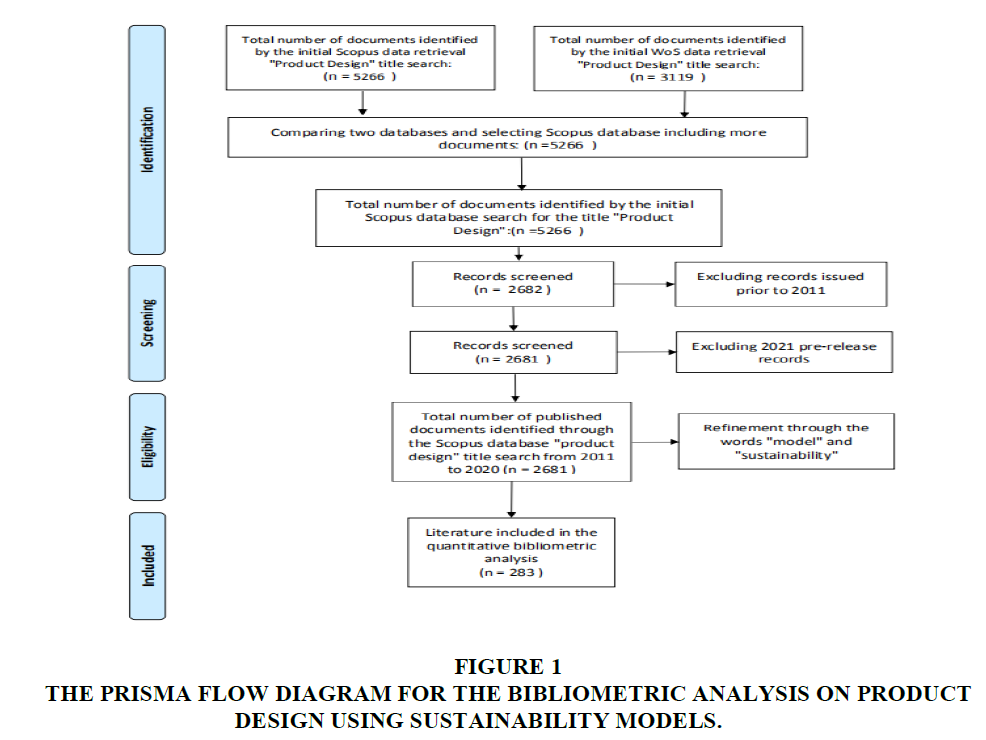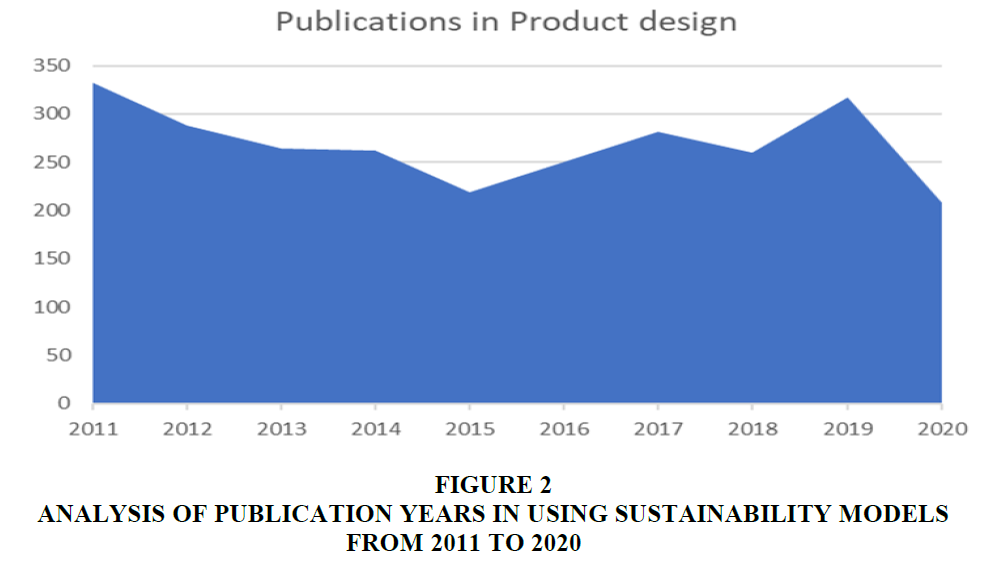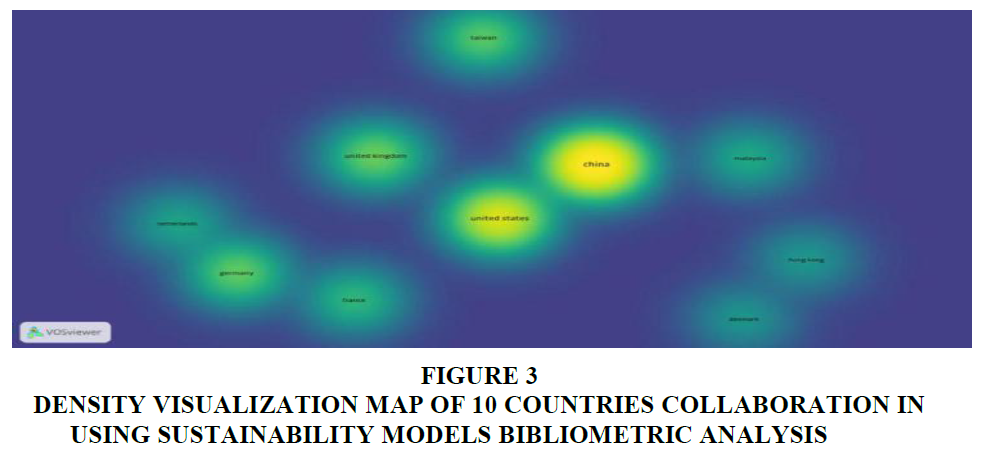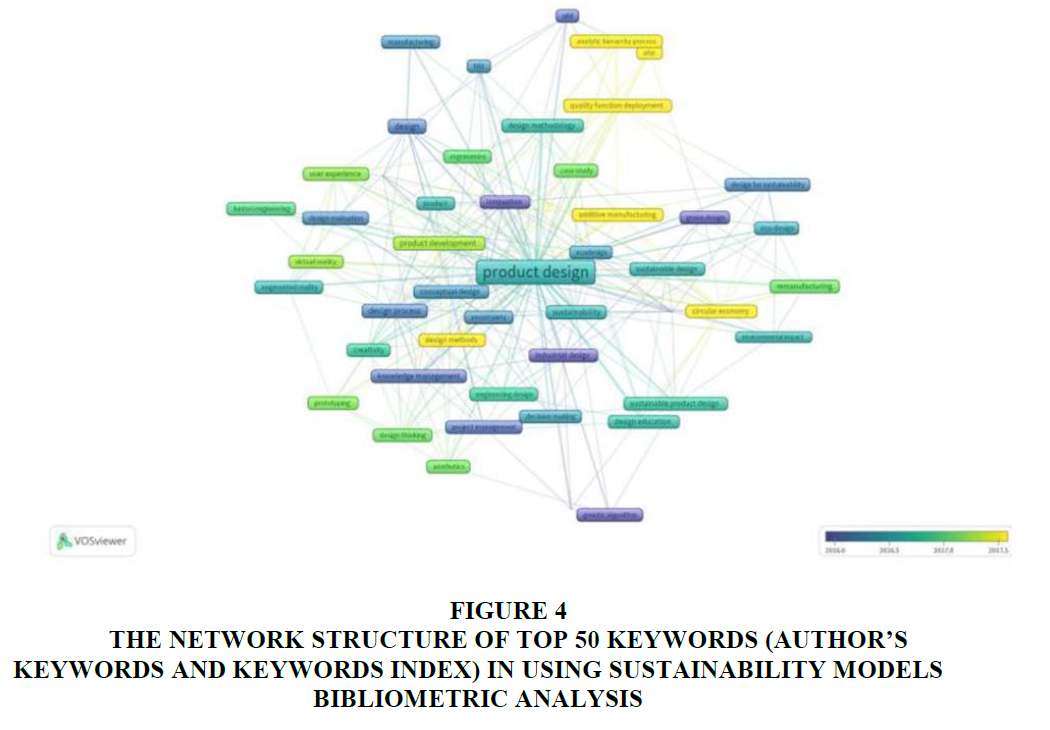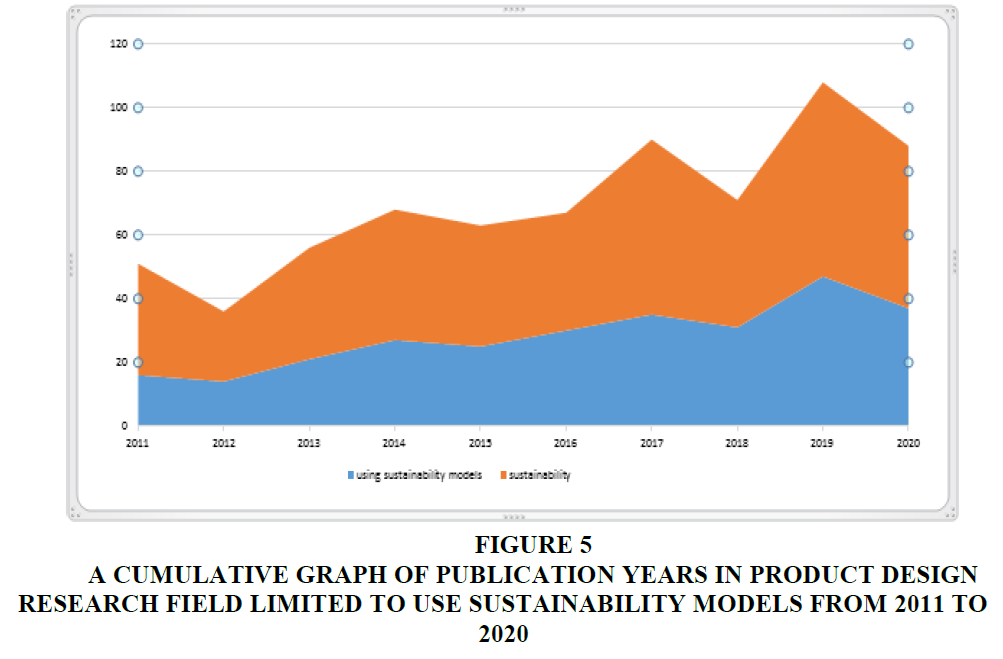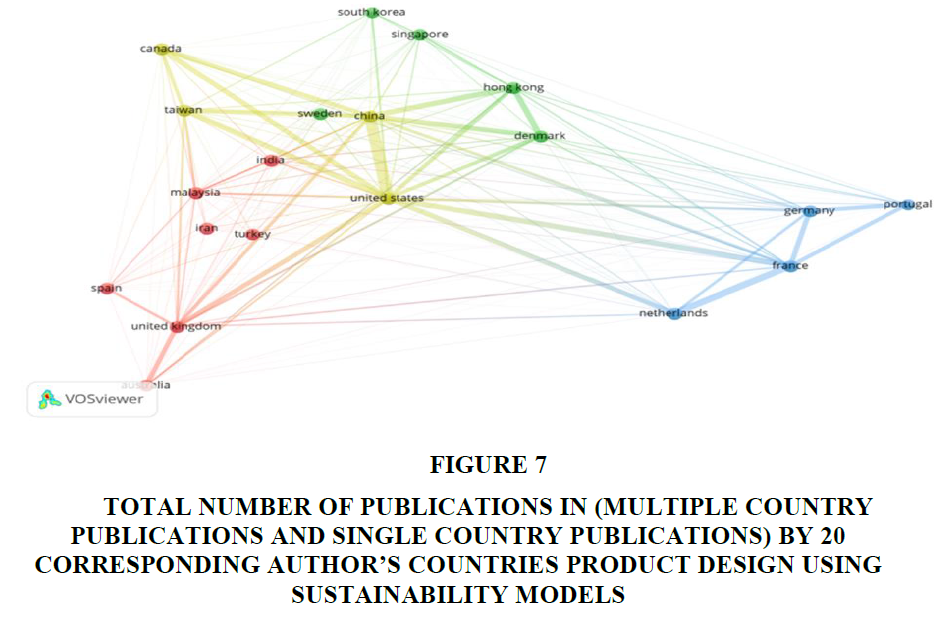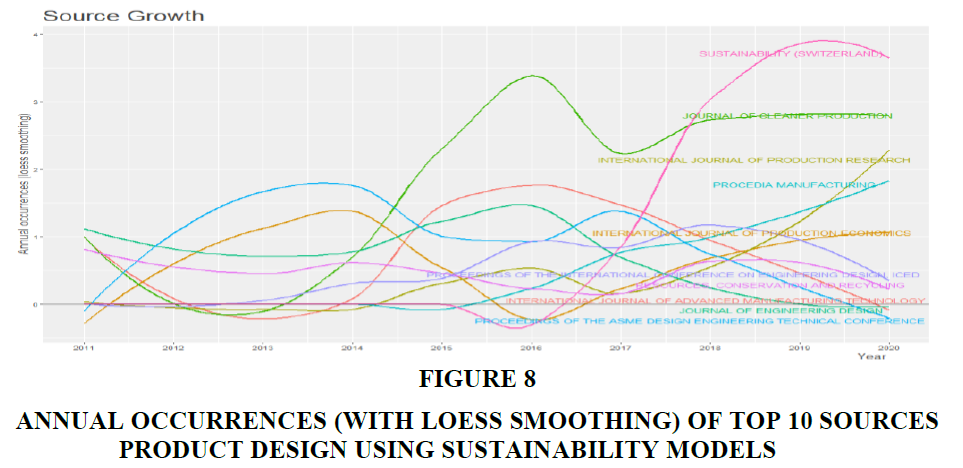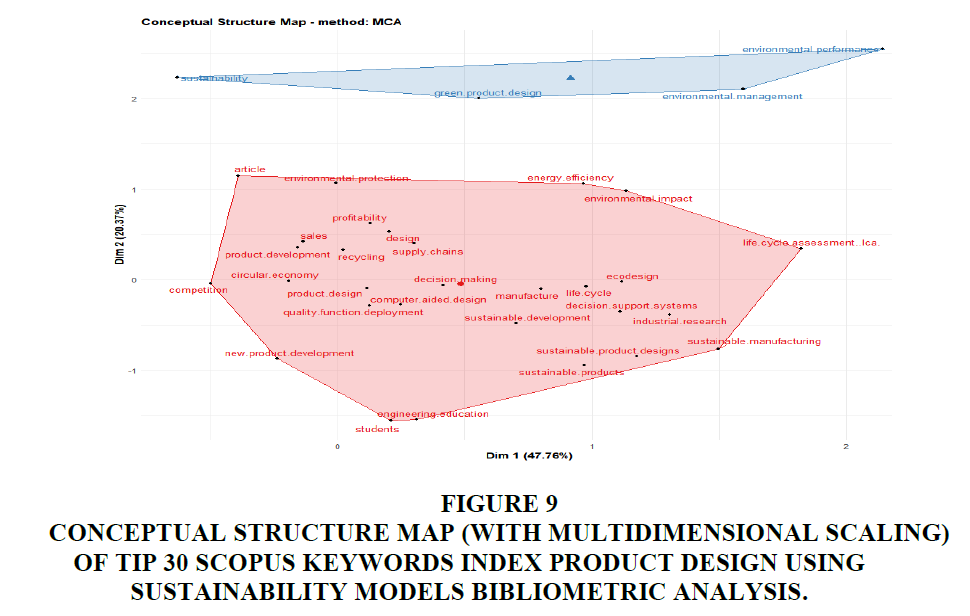Short commentary: 2021 Vol: 25 Issue: 6
Ten decades of research on sustainability of product design: A bibliometric analysis of trends a cross regions
Xu Yang, Universiti Sains Malaysia
Ahmad Zuhairi Abdul Majid, Universiti Sains Malaysia
Mu Tiantian, Building and Planning, Universiti Sains Malaysia
Zhu Guangyu, Communication University of ZheJiang
Citation Information: Yang X., Majid AZA., Tiantian M., Guangyu Z. (2021). Ten decades of research on sustainability of product design: a bibliometric analysis of trends across regions. International Journal of Entrepreneurship, 25(6), 1-18.
Abstract
The Product design has permeated various fields, and industries have also advanced the innovation and advancement of product design concepts and technologies. In the widespread implementation of the use of product design, recent research has re-examined the direction of academic rehearing the field of product design. The number of relevant publications calls for a bibliometric study to explore the most prominent keywords, countries, sources, and research clusters. In this paper, a bibliometric analysis of relevant publication in product design is conducted using data from the Scopus database from 2011-2020. The comparative analysis of the literature keywords is used to generate a model of the most high-frequency keywords under product design. The paper goes on to discuss the publication trends in product design using the model concept. The bibliometric analysis during the study period reveals annual publication counts, producing and collaborating countries, source growth rates, most frequent keywords, and research collaborations. The areas of research were divided into three main categories, namely, models used in product design; research in the area of sustainability as it relates to product design; and methods and evaluation strategies applied to product design. The qualitative analysis section of the paper is a detailed description of the most highly cited articles.
Keywords
Product Design, Model Use, Sustainability, Methodology and Evaluation, Bibliometrics, Research Productivity
Introduction
Product design, which can be replaced by industrial design at some levels, is an important part of modern design, with a complex design process involving drawings, models, materials, product structure, market research strategies, and other processes (Chandrasegaran, et al., 2013). Product design literature and data in the fields of financial performance, agriculture, chemistry, etc., will give rise to different design needs (Antle et al., 2017). Facing various product design dilemmas requires the use of appropriate tools and techniques (Lutters et al., 2014). Product design needs to consider and respect the "triple bottom line": based on environmental protection, where ecological considerations are taken into account at every step from the technical work structure; based on social expectations, where it is considered whether the designed product meets social supply and demand; and based on profit distribution, which is a combination of the two, where the profit ratio is related to environmental and market impacts (Lacasa et al., 2016).
SPD and SPD are two types of tools commonly used to test product design based on sustainability. Product design tools (SPD) are used for the three aspects of sustainability, while some product design tools (P-SPD) are used for the early design stages. Compared to these two types of tools, P-SPD tools are more mature and standardized (Ahmad et al., 2018). There is a strong focus on end-of-life (Eol) performance in product design, so environmental design (DFE) tools can assist designers, and as an aid DFE has ease of use (de Aguiar et al., 2017). The most avant-garde product design tools are VR (Virtual Reality) systems, because the product design process can be completed through scenario simulators, etc., to reduce the design will produce waste, improve the product life cycle value maximization, and irreversible energy waste problems (Chandrasegaran et al., 2013; Charter & Tischner 2017).
Validation factor analysis and structural equation modeling are used to check that product design enhances the degree to which consumers love the product, and this model facilitates the enhancement of various values in product design research (Kumar et al., 2015). Product design has a theoretical strategy model that can be used to understand customer preference bias, commercial product strategy, and government policies (Homburg et al., 2015). One of the most implicated designers are the lifecycle-based product design model for the application of design performance evaluation, such as assembly, dis-assembly, recycling, maintainability, and environmental processes (Sy & Mascle, 2011). Currently product design models are in the early stages of development and scholars in various countries around the word are using ecological product design to do sustainability and reduce the impact of environmental pollution on the planet (Hartmann & Germain, 2015).
Nowadays, the concept of sustainability has become a high-frequency, hotspot direction in the realm of product design research, and the transformation and innovation of product design have promoted the birth of this sustainable design (DFS) (Ceschin & Gaziulusoy 2016; Iqbal & Ahmad, 2021). The design and development of sustainable products has become a desired research area for scholars, which are inseparable from the concerns of consumers (de Aguiar et al., 2017). To manufacture sustainable goods, the selection of appropriate materials is of paramount importance, and how to select sustainable design materials can be done using life cycle engineering (LCE) (Iqbal et al., 2021; Zarandi et al., 2011). The life cycle of a product is the key factor to reflect the sustainability of product design, and the sustainability of product design ideas can be divided into different design stages, and the ideas and limitations of each type of sustainable design can be found for the different needs of each stage (Ahmad et al., 2018; Chen et al., 2012; Iqbal er al., 2021). For example, to address the sustainability needs of early product design, cost reduction and product quality improvement are crucial for sustainable product development. Designers should develop a checklist for new sustainable product development and work with production staff to ensure the performance and quality of sustainable products (Chen et al., 2012). In order to maximize the value of sustainability in the life cycle, many companies forget that sustainability is not about the development of new technologies, but about whether or not the development helps (Antle et al., 2017; Iqbal et al., 2021).
Compared with traditional product design, sustainable product design is more concerned with the environment, resources, utilization, and other issues. Therefore, "design efficiency" is another measure of the sustainability of product design. The two-stage Data Envelopment Analysis (DAE) model can be used to assess the design efficiency of sustainable product specifications, attributes, etc. (Chen et al., 2012). Consumers focus on three design dimensions for the sustainability of product design, namely practical, artistic and emblematical design (Khan et al., 2021). Similarly, consumers have an evaluation model for their reaction to design and can use the consumer information processing model to understand the tendency of design dimensions by observing consumers' emotional reaction (Candi et al., 2017). During the development of product design, it is essential to evaluate the life cycle and the concept of ecological design as fundamental, so it is necessary to establish decision-making model, which is conducive to the sustainability of the product design life cycle and the protection of the ecological environment (Kulatunga et al., 2015). Sustainability in product design can be a good solution to the problem of energy consumption, so the industrial energy consumption model can be used from multiple perspectives to create energy consumption analysis framework of product design systems (Bonvoisin et al., 2013).
Today, sustainability product design areas from all stages, including financial performance, agriculture, chemistry, etc., and is used to improve or enhance the shortcomings of these research areas (Iqbal & Piwowar-Sulej, 2021). Of course, due to the diversity of research areas, sustainability in product design can use various types of models to assist in solving design problems. Models in the field of chemistry, for example, are used to create a decision framework for sustainability and achieve sustainability in product design through computer-aided design tools, as well as information and communication technology models (Antle et al., 2017; Heintz et al., 2014). Readers can find relevant information and research reports in the field of sustainability research to express more clearly that sustainable models can be used in doing product design research to improve the accuracy and effectiveness of all stages of design. An overview type of paper can provide (1) basic concepts, definitions, theories, framework structure and technical information; (2) existing literature, methods used and results collated; and (3) current research in the field, high-frequency terms and trends for future development, and challenges faced (Ma and Kremer, 2016). In contrast, this paper uses bibliometric analysis, which makes it very easy for the reader to observe research trends in literature and highly summarizes the hottest current research topics.
Unlike the traditional knowledge presented in the literature and the experiences expressed by scholars, bibliometric analysis can help researchers to put a macro perspective on a field of study (Wang et al., 2020; Chen et al., 2019). Bibliometrics is defined as the measurement of scholarship based on very rich metrics such as the volume of literature published, the number of citations and author collaboration (Ghanbari et al., 2019). Similarity, bibliometrics is used as an indispensable aid to quantitative study (Li et al., 2020). The bibliometric analysis of published literature has led to different types of methodological improvements that facilitate the understanding of academic field knowledge and framework theories and assess research trends in publications (Ponce & Lozano, 2010; Akhavan et al., 2016). A bibliometric study analysis publication author country, most high frequency keywords, publication citations, and literature research trends to explore the research area with a quantitative analysis (Ebrahim, et al., 2019).
Bibliometric analysis can be used in a variety of research areas, including business strategies for the circular economy in the social sciences (Bocken et al., 2016; Khan et al., 2021), supply chains in a competitive environment (Zhu & He, 2017), two-stage supply chains and procurement strategies (Dey et al., 2019), forward-looking environmental strategies and performance (Li et al., 2016), strengthening global supply chain capabilities (Marsillac & Roh, 2014), resource council effectiveness survey reports (Khor & Udin, 2013), and other research areas. Similarly, there are bibliometric studies approaching the use of product design sustainability or model use in research areas such as sustainable waste management (Krystofik et al., 2015), the bottom line in sustainable product design (Melles, et al., 2011; Iqbal et al., 2021), evaluation of sustainable materials in product design (Reuter, 2016), product environmental design evaluation (He et al., 2018), low-carbon product design goal planning (Kuo et al., 2014), energy efficiency solutions in product design (Moon et al., 2013), lightweight product design techniques (Carruth et al., 2011). What is more special is the use of sustainability modeling, which can solve the problems faced by product design in multiple aspects and dimensions, and currently the field of integration can be compared to the field of modular product design (Bonvoisin et al., 2016). On the one hand, the previously published literature did not use the sustainability model in the field of product design research, which is conducive to scholars to explore the integration of the field. On the other hand, the results of bibliometric studies are not a substitute for qualitative peer assessment (Boons & Roome, 2005). Therefore, scholarly reviews related to the results of bibliometric analysis need to be left for scholars to observe and then use (Boons & Roome, 2005). The best way to learn more about a research area is to use a combination of qualitative and quantitative bibliometric analysis of literature (Maghami et al., 2015; Elaheh et al., 2018). Therefore, the literature for qualitative analysis in this paper is publications with top annual citation rates, which are useful for assessing the impact of literature and research trends (He et al., 2020). There is also the number of publications cited, which reflects the current hot research areas and is considered as an influential representative (Connelly et al., 2020). The goal of this paper is to explore the current state of research in the field of sustainability in product design using models in the decade 2011-2020 through bibliometric analysis and qualitative analysis of highly cited literature. The study shows the current research focus and hot spots in product design to help scholars understand the development process, current difficulties and future challenges in the field.
Methodology
The more scientific and accepted databases for literature search are Scopus and Web Of Science (WoS). Although WoS is one of the most authoritative databases for literature retrieval and analysis, Scopus provides more comprehensive coverage of journals than WoS. To select a more appropriate database, search on the subject of "product design" were conducted on both the WoS and Scopus databases. 5265 publications were retrieved from Scopus compared to 3119 publications from WoS. These were the number of documents published in all years with the phrase "product design" in the title, abstract or keywords. Due to the high number of publications, data were collected from Scopus on 15 October 2020.
In order to select the latest references, publications were elected after 2011. Therefore, it was necessary to reduce the number of publications from 5266 to 2682. This is the total number of publications on "product design" issued between 2011 and 2020, excluding pre-publication records for 2021. Hence, from 2011 to 2020, the total number of published documents identified by searching "product design" title through Scopus database is 2681.The annual number of "product design" publications, the top 20 publication countries, and the top 50 publication authors can be directly expressed by VOS software. VOS viewer is software for drawing distance-based maps. It clusters keywords retrieved from the titles and abstracts of research documents (Ebrahim et al., 2020). The visualization map of literature metrics consists of linked nodes, each node representing a keyword, a country, an institution, or an writer. The 2,681 publications were finally refined to 283 using the search terms "model" and "sustainability" (Ebrahim et al., 2020).
Bibliometrix-package this is an RTool for comprehensive scientific mapping analysis, designed for quantitative studies in scientometrics and bibliometrics. Vos tools can help import various routines of bibliographic data from famous databases WoS and Scopus impore. The main process of data collection is shown in Figure 1, which can be used as a preferred reporting item (PRISMA) for systematic reviews and meta-analysis flowcharts. It facilitates the integration of bibliometric results and qualitative analysis of publication content (Ebrahim et al., 2020).
Figure 1 The Prisma Flow Diagram for the Bibliometric Analysis on Product Design Using Sustainability Models.
Quantitative Analysis
Between 2011 and 2020, a total of 2682 papers were published in product design. Figure 2 shows the exponential trend in publications, with a peak of 332 publications in 2011, a downward trend from 2011 to 2015, and then an upward trend to 2019, with 317 publications in 2019, indicating a recent resurgence of interest in the field. Overall, the total number of papers published between 2011 and 2020 accounts for more than half of all total papers published.
Figure 3 shows the top 20 countries in product design research. According to the data analysis, these 20 countries account for 98.35% of all countries in terms of the number of publications. The top ranking Asian and Western countries each accounted for half of the total. China has published 717 papers, ranking first in the world, while the United States has published 445 papers, ranking second, and the United Kingdom with 192 papers published. These three countries are located in different area:(1) China is the best ranked country in Asia; (2) the United States performs North and South America; and (3) the United Kingdom is the most published country in Europe. Thus, each continent has countries in the field of product design research and China is the most important center for research in the field of product design (Ebrahim et al., 2020).
Figure 3 Density Visualization Map of 10 Countries Collaboration in Using Sustainability Models Bibliometric Analysis
Comparative analysis was performed by using author keywords and index keywords given by Scopus. The analysis included author keywords that appeared at least 20 times. The metric analysis included 8,885 indexed keywords, of which a total of 99 met the threshold. Figure 4 shows the 50 high-frequency keywords and the structural relationship between the keywords. Different colored keywords indicate the initial date of their associated publication, and lines indicate common links between different keywords. Publications in the product design category have been focusing on areas of ongoing research and product development since 2016.
Figure 4 The Network Structure of top 50 Keywords (Author?s Keywords and Keywords Index) in using Sustainability Models Bibliometric Analysis
Co-current analysis of author keywords in Scopus was performed, and the hottest keyword networks in the literature analyzed by VOS software were sustainable product design, modular product design, product development, and product design models. In order to identify recently added keywords, which may not occur frequently enough to be considered in Figure 4, the publication keywords from 2017 to 2018 were again collated and analyzed, and the hottest word networks that emerged were sustainability, sustainable design, and model ecological design. Therefore, this study is based on the product design under the sustainability model.
The original 2682 articles were improved by adding sustainability and modeling, and finally, 283 documents were retrieved from the Scopus database. Table 1 shows the results in full detail. There were 815 authors using sustainability models in product design research. The average number of authors per document was calculated to be 2.879, which indicates that most of the documents were the result of collaborative research by scholars. The results of data analysis showed that there were 23 single author articles on product design research under the sustainability model. There are 260 articles written by co-authors. The average citation rate of each article is 14.37, thus indicating a high number of highly cited articles and the relatively high quality of articles for scholars in this research field to reference.
| Table 1 The Occurrence of top Author’s Keywords Product Design using Sustainability Bibliometric Analysis | |
| Author’s Keywords | Occurrences |
| Product design | 63 |
| Sustainability | 25 |
| Sustainable product design | 20 |
| Sustainable design | 13 |
| Life cycle assessment | 12 |
| Circular economy | 9 |
| Circular economy | 8 |
| Sustainable manufacturing | 7 |
| Green product design | 7 |
| Remanufacturing | 6 |
| New product development | 6 |
| Design for sustainability | 6 |
| Ecodesign | 6 |
| TRIZ | 5 |
| Product design | 5 |
| Design for sustainability | 5 |
| Sustainable product development | 5 |
| Supply chain | 5 |
| Quality function deployment | 5 |
| Green design | 5 |
Figure 5 illustrates the fluctuating trend of upward or downward publications in the sustainability research area of product design. As the figure shows, the field of sustainability model use research had 47 publications in 2019, which is the highest number of publications in this research field in the last decade. The table easily shows that sustainability model use publications, from 2012 to 2017, showed a slow trend of growth, but, by 2018, a decline. Interestingly, it shows growth again in 2019 and is the highest point of publications in the last decade. This also indicates that researchers are returning the focus of product design back to the realm of sustainability.
Figure 5 A Cumulative Graph of Publication years in Product Design Research Field Limited to use Sustainability Models from 2011 to 2020
Figure 6 displays the network of correlations for the top 20 nations analyzed for product design under the sustainability model. Research collaborations between different countries are indicated by colored lines, and their size indicates the strength of collaboration between the two countries involved (Ebrahim et al., 2020). In the research area of product design under the sustainability model, the United States is the country with most publications, topping the list with a total of 64 articles in this area. These publications were mainly in collaboration with China, followed by India, Sweden, Denmark and Hong Kong. Since 2011, China ranks second with 49 publications, accounting for more than 17% of the field of study. As shown by the correlation network, there are more joint papers between China and Switzerland. Between 2011 and 2020, the UK published 25 papers in the area of product design under the sustainability model and Taiwan published 22. The other remaining collaborating countries are Germany, Malaysia, the Netherlands, and Canada. The different colors in Figure 6 display diverse cluster of international research collaborations: (1) The USA, China, Taiwan, and Canada clusters; (2) Germany, France, the Netherlands, and Portugal. This linkage structure helps scholars from all over the world to find peers in their fields of research and to collaborate to produce more research results.
Figure 6 The Network Structure of Top 20 Countries Collaboration in Product Design Using Sustainability Models Bibliometric Analysis
Figure 7 shows the number of multiple and single publications in product design sustainability models. The top 20 countries are selected according to the number of publications. The overall top-ranking Chinese author has published a total of 19 papers, including 4 multinational and 15 single-country publications. Malaysia ranked among the top three countries with the highest number of publications by a single author, with 9 papers. Other countries with only single author publications include Japan, Australia, Brazil, Iran, and Italy. This country accounts for more than 29% of the total number of product design research areas in sustainability models. Thus, as shown in Figure 7, most published papers are written by authors from the same country, which means that authors usually work with people from the same country.
Figure 7 Total Number of Publications in (Multiple Country Publications and Single Country Publications) by 20 Corresponding Author?s Countries Product Design Using Sustainability Models
Figure 8 illustrates the 10-year evolution of the product design research area of the sustainability model. It also shows the different number of documents released by the top 10 most productive sources between 2011 and 2020. As a result, the INTERNATIONAL JOURNAL OF PRODUCTION RESEARCH has begun to focus on the field of sustainable product design research, so scholars can look to this journal. The most popular journal in the field, but publications is stable from 2018 to 2020. The literature on product design for sustainability models is published, but there are relatively few publications in this area of research for the years 2019 and 2020.
Figure 8 Annual Occurrences (with Loess Smoothing) of top 10 Sources Product Design Using Sustainability Models
Table 1 shows the emergence of writer keywords in the product design search literature for the continuity model between 2011 and 2020. The table completely shows the keywords that appear at least five times in publications in this research area. Therefore, the total number of author keywords counted is 838. Therefore, 20 keywords meet the threshold. Product design was the most frequent keyword within the aggregate 63 existences, which is the best phrase for searching the literature. By combing the publications, the keywords were sustainability, sustainable design, and sustainable product design. As shown in Table 1, this author keyword was always around sustainability or green eco-development in product design (Ebrahim et al., 2020).
Figure 9 shows keyword indexes extracted from the Scopus database and aggregated into different categories using Conceptual Structure Map - Method:MDS in biblioshiny for bibliometrix software. The conceptual structure of the first 30 indexed keywords shows that publications on product design for continuity models between 2011 and 2020 can be grouped into two categories. The cluster in red in Figure 9 is the larger and more comprehensive one, bringing together the indexing keywords of all publications included in the analysis dataset. This cluster has 26 high-frequency search terms, such as sustainability, eco-design, product development, new product development (NPD), industrial research, environmental protection, and so on. The second blue cluster contains four keywords, which are sustainable, green product design, environmental management, and environmental performance. It is evident that researchers who focus on the development of product design are more inclined to environmental protection and sustainable development.
Figure 9 Conceptual Structure Map (with Multidimensional Scaling) of tip 30 Scopus Keywords Index Product Design using Sustainability Models Bibliometric Analysis.
Qualitative Analysis
Aggregation of keywords for product design research trends and the current state of art is the use of sustainability models. All keyword in the clustering are indexed by extracting keywords from publications to indicate the research direction. In part, compelling research clusters identified through bibliometric analysis were qualitatively analyzed; the automatic clustering of keyword indexes was combined with qualitative analysis of publication content (Ebrahim et al., 2020).
Searching through the Scopus database, all publications in the product design using the persistence model were sorted in descending order of the average annual citation rate. It is the citation rate of each paper, divided by the number of years since publication. The study of these high citation rate documents facilitates the study of the most critical research topics in the field. Through the statistical analysis of VOS, Biblioshiny For Bibliometrix, Qiqqa, and other software, the top 50 papers with the highest citation rates were divided into two categories (Ebrahim et al., 2020).
From the top 50 articles with the highest citation rates, the literature with the highest average number of annual citations was selected for more accurate evaluation and analysis. The articles selected were those that cited at any rate 10 words per year within 50 articles with an average citation rate of 223.5-10.16.The first 14 documents met the above requirements and could be used for detailed qualitative analysis, as the subsequent average annual citation rate dropped below 9.7.
Application Models And Methods For Sustainable Product Design
In today's manufacturing industry, the aim is to design sustainable products by reducing costs, or by protecting the environment and recycling resources. But in order to meet market and consumer demands, models and approaches must be applied to achieve these goals. Tools with a central purpose of protecting the environment are essential, such as Quality Function Deployment (QFDE), which is a collection of consumer voice, environmental voice and quality characteristics. QFDE, Fuzzy Decision Experimentation and Evaluation Lab, and Fuzzy Analysis Network Process (FANP) are models and methods that can be used by companies and designers to capture the best design processes and standards for environmental sustainability design. By incorporating QFDE into FANP, it is possible to derive a prioritization technique that can be applied early in the design process to benefit LCE (de Aguiar et al., 2017), as the process does not require detailed product information content. Of course, this model has already been applied in actual enterprises, and began to be further promoted in research and development.
So, how is the method chosen for sustainable product design. First of all, the researchers and decision-making members using the model were simply not familiar with dry transformers and the use of average methods. To fuse QFDE and FANP, it is important to understand the weight of technical requirements, as the development process is long-periodic because of the common items and patterns that are applied to the matrix series. Therefore, doing research on sustainable products for project fusion, designers must consider cost issues, product quality issues, and environmental pollution issues, which are the most important aspects of the sustainable design concept. In addition, to achieve the accuracy of the matrix series, a queue needs to be set, so the experts and scholars face time-consuming difficulties. Therefore, the MMDE algorithm can be used to represent matrices with a relational graph of queue values or binary. By using MMDE algorithm, the minimum influence value in the set can be regarded as the queue value. At present, Professors Li and Zeng have proposed the method of constructing influence relation graph and binary matrix.
Knowing the matrix approach to sustainable product design models, scholars can gain a clearer understanding of the practical aspects of sustainable design (DFS). By applying the integrated QFDE methodology to explore sustainable product design, there is a greater focus on cost, product quality and environmental criteria, and QFDE can be used in all phases of product design to help designers or enterprises make efficient decisions. QFDE can also be used with other models to help manufacturers in other industries in their sustainable product design process. Social concerns are an important factor in sustainable product design, but QFDE's modeling framework is not as complete as it could be, and only considers the entire product life cycle. In addition, QFDE needs goal planning models to detect and avoid as much as possible unexpected variability in the manufacturing process.
Evolving Systems for Sustainable Product Design
All things, concepts and ideas can be organized chronologically, for the evolution of sustainable product design. Equally feasible. Then it can be divided into four dimensions according to time: product, product service system, spatial society and socio-technical system (de Aguiar et al., 2018). Of course product design is a complex and difficult process to control, and only when design goals are clearly defined will the design process be methodical and rational. The purpose of understanding the evolution of DFS is to identify its evolutionary framework and approach, and to identify how the previous focus on technology and products has been transformed into large-scale systems change. At present, product design has improved greatly in terms of knowledge acquisition and expression. It is sometimes useful to review previous research and integrate it with current research to facilitate the subsequent development of product research.
It is also essential to understand what product design is, and the field of product design research will change as environmental factors change and definitions and understanding change. Of course the same production of a product is different for different companies or teams developing it. On the whole, product design cannot be separated from two contexts, the first is engineering and the second is design. In short, the design that is directed to the purpose is product design, because teleology is engineering design. Then the concept of the design process in product design, which is also an important basis for its evolution, such as 1. conceptual design; 2. mapping and representation of functions; 3. modeling and simulation; 4. ontology and net semantics, these design concepts are also ordered over time. Currently, the actual process of product design begins with conceptual sketching, followed by design decision making, followed by exploration and computational support in design, and finally the most current design with virtual reality (VR) support. In fact, no matter how much product design changes, it always operates around a life cycle.
Therefore, exploring evolving systems for sustainable product design will ultimately translate into the field of future research trends. Today, we are at the periphery of product design method implementation and knowledge extraction. Certainly, certain specific influences have already influenced and changed DFS, and perhaps the trends that may be studied in the near future are: 1. the big explosion of wiki databases; 2. problem solvers (the rise of artificial intelligence); 3. design bio-sensing technologies; 4. large-scale collaborative product shelving; 5. naturalization of interactive interfaces; and 6. sustainable systems. Currently, product conception and democratization are the two major trends that are imperative, and two influences: (1) designing products to be more user-friendly and user-friendly, and (2) manufacturing and supply chains are expanding wirelessly. Therefore, sustainable product design is an irreversible research trend in the current world, and all business model design will inevitably include the DFS platform as an indicator.
Conclusion
This problem offers a full quantitative and qualitative analysis, on account of the literature on product design from 2011 to 2020 Moamen products retrieved from the Scopus database. A bibliometric analysis of product design publications was conducted, which led to the identification of the latest research areas and trends, namely sustainability. The dataset was refined through in-depth learning exploring developments in publication year, country, source, keywords and themes. Product design using the sustainability model had a slow trend of growth in the previous decade and has potential for future growth. The analysis of collaboration scholars between countries is useful for new scholars to identify potential groups of collaborators. According to an analysis of country-related publication literature from around the world, China is the country with the most publications in the field and the one that collaborates most closely with scholars from other countries. Likewise, the United States has the second highest number of publications in collaboration with scholars from other countries. By calculating author keywords and indexing keywords over a ten-year period, it is possible to identify the research hotspots. The analysis of author keywords shows that the research results on sustainability in product design are mainly related to sustainability, sustainable product design, sustainable design, life cycle assessment, Circular economy, circular economy, sustainable manufacturing, design for sustainability, sustainable product development, etc. Factor analysis of the keyword index and qualitative analysis of the content of the most frequently used publications shows that the same research themes focus mainly on sustainability and the use of models and methods.
The aim of this paper is to show how the frontiers of product design research in the field of sustainability are changing in the period 2011-2020. The paper is crucial for understanding the evolution of product design, the use of models and methods used in the concept of sustainability and the application of the field's further research directions. As a result, there will be a wide range of researchers working on topical research topics in sustainable product design, focusing on the development of sustainability concepts, resulting in a large number of publications.
References
- Ahmad, S., Wong, K. Y., Tseng, M. L., & Wong, W. P. (2018). Sustainable product design and development: A review of tools, applications and research prospects. Resources, Conservation and Recycling, 132, 49-61.
- Akhavan, P., Ebrahim, N. A., Fetrati, M. A., & Pezeshkan, A. (2016). Major trends in knowledge management research: a bibliometric study. Scientometrics, 107(3), 1249-1264.
- Antle, J. M., Basso, B., Conant, R. T., Godfray, H. C. J., Jones, J. W., Herrero, M., ... & Wheeler, T. R. (2017). Towards a new generation of agricultural system data, models and knowledge products: Design and improvement. Agricultural systems, 155, pp.255-268.
- Bocken, N. M., De Pauw, I., Bakker, C., & Van Der Grinten, B. (2016). Product design and business model strategies for a circular economy. Journal of industrial and production engineering, 33(5), 308-320.
- Bonvoisin, J., Halstenberg, F., Buchert, T., & Stark, R. (2016). A systematic literature review on modular product design. Journal of Engineering Design, 27(7), 488-514.
- Boons, F., & Roome, N. (2005). Sustainable enterprise in clusters of innovation (No. 2013/14355). ULB--Universite Libre de Bruxelles.
- Candi, M., Jae, H., Makarem, S., & Mohan, M. (2017). Consumer responses to functional, aesthetic and symbolic product design in online reviews. Journal of Business Research, 81, 31-39.
- Carruth, M. A., Allwood, J. M., & Moynihan, M. C. (2011). The technical potential for reducing metal requirements through lightweight product design. Resources, Conservation and Recycling, 57, 48-60.
- Ceschin, F., & Gaziulusoy, I. (2016). Evolution of design for sustainability: From product design to design for system innovations and transitions. Design studies, 47, 118-163.
- Chandrasegaran, S. K., Ramani, K., Sriram, R. D., Horváth, I., Bernard, A., Harik, R. F., & Gao, W. (2013). The evolution, challenges, and future of knowledge representation in product design systems. Computer-aided design, 45(2), 204-228.
- Charter, M., & Tischner, U. (Eds.). (2017). Sustainable solutions: developing products and services for the future. Routledge.
- Chen, C., Zhu, J., Yu, J. Y., & Noori, H. (2012). A new methodology for evaluating sustainable product design performance with two-stage network data envelopment analysis. European Journal of Operational Research, 221(2), 348-359.
- Chen, Y., Jin, Q., Fang, H., Lei, H., Hu, J., Wu, Y., ... & Wan, Y. (2019). Analytic network process: Academic insights and perspectives analysis. Journal of Cleaner Production, 235, 1276-1294.
- Connelly, T. M., Malik, Z., Sehgal, R., Byrnes, G., Coffey, J. C., & Peirce, C. (2020). The 100 most influential manuscripts in robotic surgery: a bibliometric analysis. Journal of robotic surgery, 14(1), 155-165.
- de Aguiar, J., de Oliveira, L., da Silva, J. O., Bond, D., Scalice, R. K., & Becker, D. (2017). A design tool to diagnose product recyclability during product design phase. Journal of Cleaner Production, 141, 219-229.
- Dey, K., Roy, S., & Saha, S. (2019). The impact of strategic inventory and procurement strategies on green product design in a two-period supply chain. International Journal of Production Research, 57(7), 1915-1948.
- Ale Ebrahim, S., Ashtari, A., Zamani Pedram, M., & Ale Ebrahim, N. (2019). Publication trends in drug delivery and magnetic nanoparticles. Nanoscale research letters, 14(1), 1-14.
- Ebrahim, S. A., Poshtan, J., Jamali, S. M., & Ebrahim, N. A. (2020). Quantitative and qualitative analysis of time-series classification using deep learning. IEEE Access, 8, 90202-90215.
- Elaheh, F., Nor, M. M., Abbas, G. B., Nader, A. E., & Nasrin, M. (2018). Five Decades of Scientific Development on" Attachment Theory": Trends and Future Landscape. Pertanika Journal of Social Sciences & Humanities, 26(3).
- Ghanbari Baghestan, A., Khaniki, H., Kalantari, A., Akhtari-Zavare, M., Farahmand, E., Tamam, E., ... & Danaee, M. (2019). A Crisis in “Open Access”: Should Communication Scholarly Outputs Take 77 Years to Become Open Access?. SAGE Open, 9(3), 2158244019871044.
- Hartmann, J., & Germain, R. (2015). Understanding the relationships of integration capabilities, ecological product design, and manufacturing performance. Journal of Cleaner Production, 92, 196-205.
- He, B., Xiao, J., & Deng, Z. (2018). Product design evaluation for product environmental footprint. Journal of Cleaner Production, 172, 3066-3080.
- He, L., Fang, H., Wang, X., Wang, Y., Ge, H., Li, C., ... & He, H. (2020). The 100 most-cited articles in urological surgery: A bibliometric analysis. International Journal of Surgery, 75, pp.74-79.
- Heintz, J., Belaud, J. P., & Gerbaud, V. (2014). Chemical enterprise model and decision-making framework for sustainable chemical product design. Computers in Industry, 65(3), 505-520.
- Homburg, C., Schwemmle, M., & Kuehnl, C. (2015). New product design: Concept, measurement, and consequences. Journal of marketing, 79(3), 41-56.
- Iqbal, Q., & Ahmad, N. H. (2021). Sustainable development: The colors of sustainable leadership in learning organization. Sustainable Development, 29(1), 108-119.
- Iqbal, Q., Ahmad, N. H., & Halim, H. A. (2020). How Does Sustainable Leadership Influence Sustainable Performance? Empirical Evidence From Selected ASEAN Countries. SAGE Open, 10(4), 2158244020969394.
- Iqbal, Q., Ahmad, N. H., & Li, Y. (2021). Sustainable Leadership in Frontier Asia Region: Managerial Discretion and Environmental Innovation. Sustainability, 13(9), 5002.
- Iqbal, Q., Ahmad, N. H., & Li, Z. (2021). Frugal-based innovation model for sustainable development: technological and market turbulence. Leadership & Organization Development Journal.
- Iqbal, Q., Ahmad, N. H., Li, Z., & Li, Y. (2021). To walk in beauty: Sustainable leadership, frugal innovation and environmental performance. Managerial and Decision Economics.
- Piwowar‐Sulej, K. (2021). Core functions of Sustainable Human Resource Management. A hybrid literature review with the use of H‐Classics methodology. Sustainable Development.
- Khor, K. S., & Udin, Z. M. (2013). Reverse logistics in Malaysia: Investigating the effect of green product design and resource commitment. Resources, Conservation and Recycling, 81, 71-80.
- Khan, R. U., Saienko, V., & Tolchieva, H. (2021). Dependence of the Company’s Reputation and the Quality of Customer Relations. Ikonomicheski Izsledvania, 2, 159-176.
- Khan, R. U., Salamzadeh, Y., Kawamorita, H., & Rethi, G. (2021). Entrepreneurial Orientation and Small and Medium-sized Enterprises’ Performance; Does ‘Access to Finance’Moderate the Relation in Emerging Economies?. Vision, 25(1), 88-102.
- Krystofik, M., Wagner, J., & Gaustad, G. (2015). Leveraging intellectual property rights to encourage green product design and remanufacturing for sustainable waste management. Resources, Conservation and Recycling, 97, 44-54.
- Kulatunga, A. K., Karunatilake, N., Weerasinghe, N., & Ihalawatta, R. K. (2015). Sustainable manufacturing based decision support model for product design and development process. Procedia CIRP, 26, 87-92.
- Kumar, M., Townsend, J. D., & Vorhies, D. W. (2015). Enhancing consumers' affection for a brand using product design. Journal of Product Innovation Management, 32(5), 716-730.
- Kuo, T. C., Chen, H. M., Liu, C. Y., Tu, J. C., & Yeh, T. C. (2014). Applying multi-objective planning in low-carbon product design. International journal of precision engineering and manufacturing, 15(2), 241-249.
- Lacasa, E., Santolaya, J. L., & Biedermann, A. (2016). Obtaining sustainable production from the product design analysis. Journal of Cleaner Production, 139, 706-716.
- Li, L., Lu, J., Fang, H., Yin, Z., Wang, T., Wang, R., ... & Wan, Y. (2020). Lattice Boltzmann method for fluid-thermal systems: Status, hotspots, trends and outlook. IEEE Access, 8, 27649-27675.
- Li, S., Jayaraman, V., Paulraj, A., & Shang, K. C. (2016). Proactive environmental strategies and performance: Role of green supply chain processes and green product design in the Chinese high-tech industry. International Journal of Production Research, 54(7), 2136-2151.
- Lutters, E., Van Houten, F. J., Bernard, A., Mermoz, E., & Schutte, C. S. (2014). Tools and techniques for product design. CIRP Annals, 63(2), pp.607-630.
- Ma, J., & Kremer, G. E. O. (2016). A systematic literature review of modular product design (MPD) from the perspective of sustainability. The International Journal of Advanced Manufacturing Technology, 86(5), 1509-1539.
- Maghami, M. R., esmaeil Rezadad, M., Ebrahim, N. A., & Gomes, C. (2015). Qualitative and quantitative analysis of solar hydrogen generation literature from 2001 to 2014. Scientometrics, 105(2), 759-771.
- Marsillac, E., & Roh, J. J. (2014). Connecting product design, process and supply chain decisions to strengthen global supply chain capabilities. International Journal of Production Economics, 147, 317-329.
- Melles, G., de Vere, I., & Misic, V. (2011). Socially responsible design: thinking beyond the triple bottom line to socially responsive and sustainable product design. CoDesign, 7(3-4), 143-154.
- Moon, K. K. L., Youn, C., Chang, J. M., & Yeung, A. W. H. (2013). Product design scenarios for energy saving: A case study of fashion apparel. International Journal of Production Economics, 146(2), 392-401.
- Ponce, F. A., & Lozano, A. M. (2010). Highly cited works in neurosurgery. Part I: the 100 top-cited papers in neurosurgical journals: A review. Journal of neurosurgery, 112(2), 223-232.
- Reuter, B. (2016). Assessment of sustainability issues for the selection of materials and technologies during product design: a case study of lithium-ion batteries for electric vehicles. International Journal on Interactive Design and Manufacturing (IJIDeM), 10(3), 217-227.
- Sy, M., & Mascle, C. (2011). Product design analysis based on life cycle features. Journal of Engineering Design, 22(6), 387-406.
- Wang, C., Lim, M. K., Zhao, L., Tseng, M. L., Chien, C. F., & Lev, B. (2020). The evolution of Omega-The International Journal of Management Science over the past 40 years: A bibliometric overview. Omega, 93, 102098.
- Zarandi, M. H. F., Mansour, S., Hosseinijou, S. A., & Avazbeigi, M. (2011). A material selection methodology and expert system for sustainable product design. The International Journal of Advanced Manufacturing Technology, 57(9-12), 885-903.
- Zhu, W., & He, Y. (2017). Green product design in supply chains under competition. European Journal of Operational Research, 258(1), 165-180.
